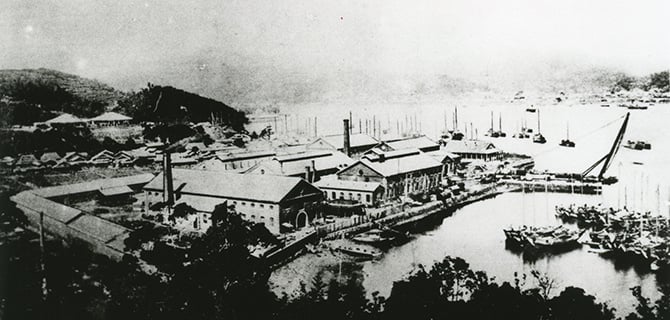HISTORY
Establishment: Pre-WWII
—Helping Japan along the Path to Becoming a Modern Nation

The history of MHI begins with our 1884 start of a full-fledged shipbuilding business in Nagasaki. After that point, we made rapid progress as we pursued the advances taking place in Europe and the United States. In addition to shipbuilding, we drove our growth by building automobiles, aircraft, turbines, and internal-combustion engines. Later, we also turned our world-leading technologies to the manufacture of products to meet military demand, such as battleships and fighters.
Post-WWII: High-Growth Period
ーA Key Player in Turning Japan into a Nation of Abundance

Post-war, in 1950, in line with the GHQ's policy of dissolving large industrial groups (zaibatsu), MHI was divided into three independent and competing companies. In addition to providing such heavy equipment as tankers and gas turbines, we supported Japan's reconstruction across a broad range of product fields, including motor scooters and air conditioners. The three companies integrated in 1964, and we played a role in Japan's rapid economic growth through the development and production of such social infrastructure as power plants and bridges as well as container carriers, monorail systems, and other transportation equipment.
Slowing Japanese Economic Growth
—Stagnating Growth as the Japanese Economy Slows

The 1973 oil crisis marked the end of Japan's rapid economic growth and had a major impact on MHI's business, particularly in shipbuilding. After that point, we established an industrial machinery business and enjoyed steady expansion until Japan again entered a period of slow growth following the bursting of its economic bubble. During that period, we succeeded in launching rockets and expanded our business domains to include aerospace. Although we continued to hone our leading-edge technologies, annual net sales remained around the ¥3 trillion level for approximately 30 years.
Toward an Era of Sustainability and Diversity
ーPursuit of New Growth by Becoming a Global Company

Although growth in Japan has leveled off, the economies of overseas emerging countries have been expanding rapidly, pushing up demand for infrastructure development. Also, amid a growing sense of crisis about climate change and the depletion of natural resources, environmental protection has become a consistent theme worldwide.
For MHI, which has supplied diverse infrastructure over many years and pursued environmentally friendly technologies since the oil crisis, this situation has presented new opportunities for growth, and we are pursuing the path to becoming a global company.